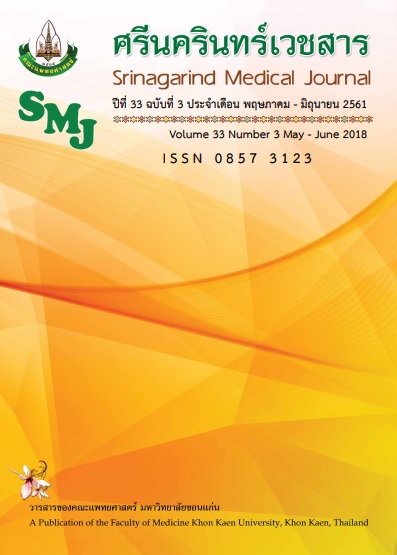Using Supraglottic Airway Devices: Laryngeal Mask Airway in Emergency Medical Services
Abstract
Background and Objectives: Airway management is important in the care of emergency patients to prevent airway obstruction and hypoxia. Supraglottic Airway Devices: Laryngeal Mask Airway (LMA) is a device used to manage airways outside the hospital. A study of the use of emergency medical equipment will improve the guideline for pre-hospital airway management.
Methods: This was a descriptive study in patients with airway management prior to hospital in emergency medical services with cardiac arrest, Glasgow coma score below 9 and no adequate saturation with a non-rebreathing mask
Results: The total number of 44 participants, 29 male (65.91%) mean age is 54.2 + 8.15 years. The most indication is cardiac arrest 19 cases (43.18%) insertion was performed in first attempt successful in 40 cases (90.91%) and no complication after use devices 33 cases (75.00 %)
Conclusion: The use of Supraglottic airway devices: LMA in the emergency medical system is safe and effective.
การใช้อุปกรณ์ช่วยหายใจเหนือกล่องเสียงชนิด LMA ในระบบการแพทย์ฉุกเฉิน
กรกฏ อภิรัตน์วรากุล, กมลวรรณ เอี้ยงฮง, วัชระ รัตนสีหา, มธุรส บูรณศักดา, ปริวัฒน์ ภู่เงิน, วัชรพงศ์ พุทธิสวัสดิ์
ภาควิชาเวชศาสตร์ฉุกเฉิน คณะแพทยศาสตร์ มหาวิทยาลัยขอนแก่น
หลักการและวัตถุประสงค์: การจัดการทางเดินหายใจเป็นสิ่งสำคัญในการดูแลผู้ป่วยฉุกเฉินเพื่อป้องกันภาวะทางเดินหายใจอุดกั้นและการขาดออกซิเจน อุปกรณ์ช่วยหายใจเหนือกล่องเสียงชนิด LMA เป็นอุปกรณ์ที่ใช้ในการจัดการทางเดินหายใจนอกโรงพยาบาล การศึกษาการใช้อุปกรณ์ในระบบการแพทย์ฉุกเฉินจะช่วยเพิ่มแนวทางการการจัดการทางเดินหายใจนอกโรงพยาบาล
วิธีการศึกษา: เป็นการศึกษาเชิงพรรณนาในผู้ป่วยฉุกเฉินที่ได้รับการจัดการทางเดินหายใจในระบบการแพทย์ฉุกเฉิน โดยมีลักษณะดังนี้ ภาวะหัวใจหยุดเต้นหรือกลาสโกว์ โคม่า สเกลน้อยกว่า 9 คะแนนหรือ ช่วยหายใจด้วยหน้ากากช่วยหายใจแล้วไม่สามารถจัดการทางเดินหายใจได้
ผลการศึกษา: มีผู้เข้าร่วมการศึกษา 44 ราย เป็นเพศชายจำนวน 29 ราย (ร้อยละ 65.91) โดยมีอายุเฉลี่ย 54.2 + 8.15 ปี ข้อบ่งชี้ในการใช้อุปกรณ์มากที่สุด คือ ภาวะหัวใจหยุดเต้น 19 ราย (ร้อยละ 43.18) จำนวนครั้งที่ใส่อุปกรณ์สำเร็จพบว่าครั้งที่ 1 จำนวน 40 ราย (ร้อยละ 90.91) และส่วนใหญ่ไม่มีผลแทรกซ้อนหลังใส่อุปกรณ์ 33 ราย (ร้อยละ 75.00)
สรุป: การใช้อุปกรณ์ช่วยหายใจเหนือกล่องเสียงชนิด LMA ในระบบการแพทย์ฉุกเฉินมีความปลอดภัยและประสิทธิภาพสูง
References
2. Esposito TJ, Sanddal ND, Hansen JD, Reynolds S. Analysis of preventable trauma deaths and inappropriate trauma care in a rural state. J Trauma 1995; 39: 955–62.
3.Lockey DJ, Healey B, Crewdson K. Advanced airway management is necessary in Prehospital trauma patients. Br J Anaesth 2015; 114: 657–62.
4. Fevang E, Lockey D, Thompson J, Lossius HM. The top five research priorities in physician-provided pre-hospital critical care: a consensus report from a European research collaboration. Scand J Trauma 2011; 19: 57-9.
5. Adnet F, Jouriles NJ, Le Toumelin P, Hennequin B, Taillandier C, Rayeh F, et al. Survey of out-of-hospital emergency intubations in the French prehospital medical system: a multicenter study. Ann Emerg Med 1998; 32: 454–60.
6. Breckwoldt J, Klemstein S, Brunne B, Schnitzer L, Arntz HR, Mochmann HC. Expertise in prehospital endotracheal intubation by emergency medicine physicians-Comparing ‘proficient performers’ and ‘experts’. Resuscitation 2012; 83: 434–9.
7. Breckwoldt J, Klemstein S, Brunne B, Schnitzer L, Mochmann HC, Arntz HR. Difficult prehospital endotracheal intubation - predisposing factors in a physician based EMS. Resuscitation 2011; 82: 1519–24.
8. Chesters A, Keefe N, Mauger J, Lockey D. Prehospitalanaesthesia performed in a rural and suburban air ambulance service staffed by a physician and paramedic: a 16-month review of practice. Emerg Med J 2014: 31: 65-8.
9. Harris T, Lockey D. Success in physician prehospital rapid sequence intubation: what is the effect of base speciality and length of anaesthetic training. Emerg Med J 2011; 28: 225-9.
10. Lossius HM, Roislien J, Lockey DJ. Patient safety in pre-hospital emergency tracheal intubation: a comprehensive meta-analysis of the intubation success rates of EMS providers. Crit Care 2012; 11: R24.
11. Rognas L, Hansen TM, Kirkegaard H, Tonnesen E. Pre-hospital advanced airway management by experienced anaesthesiologists: a prospective descriptive study. Scand J Trauma 2013; 21: 58.
12. Timmermann A, Eich C, Russo SG, Natge U, Brauer A, Rosenblatt WH, et al. Prehospital airway management: a prospective evaluation of anaesthesia trained emergency physicians. Resuscitation 2006; 70: 179–85.
13. Von Vopelius-Feldt J, Benger JR. Prehospital anaesthesia by a physician and paramedic critical care team in Southwest England. Eur J Emerg Med 2013; 20: 382-6.
14. Wang HE, O’Connor RE, Domeier RM. Prehospital rapid-sequence intubation. Ann Surg 2010; 252 : 959-65.
15. Bernard SA, Nguyen V, Cameron P, Masci K, Fitzgerald M, Cooper DJ, et al. Prehospital rapid sequence intubation improves functional outcome for patients with severe traumatic brain injury: a randomized controlled trial. Ann Surg 2010; 252: 959–65.
16. Badjatia N, Carney N, Crocco TJ, Fallat ME, Hennes HM, Jagoda AS, et al. Guidelines for prehospital management of traumatic brain injury 2nd edition. Prehos Emerg Care 2008; 12 (Suppl 1): S1–S52.
17. Juul N, Sollid S, Sundstrom T, Kock-Jensen C, Eskesen V, Bellander BM, et al. Scandinavian guidelines on the pre-hospital management of traumatic brain injury. Ugeskr Laeger 2008;170: 2337–41.
18. Franschman G, Peerdeman SM, Greuters S, Vieveen J, Brinkman AC, Christiaans HM, et al. Prehospital endotracheal intubation in patients with severe traumatic brain injury: guidelines versus reality. Resuscitation 2009; 80: 1147–51.
19. Bosch J, Nooij DJ, Visser M, Cannegieter C, Terpstra NJ, Heringhaus C, et al. Prehospital use in emergency patients of a laryngeal mask airway by ambulance paramedics is a safe and effective alternative for endotracheal intubation. Emerg Med J 2014; 31: 750-3.
20. Leif R, Hansen TM, Kirkegaard. Standard operating procedure changed pre-hospital critical care anaesthesiologists’behaviour: a quality control study. Resuscitation 2013; 21: 84-7.
21. Mona T, Troels MH, Leif R. Anaesthetist-provided pre-hospital advanced airway management in children: a descriptive study. Resuscitation 2015; 23: 61-3.
22. Lockey D, Crewdson K, Weaver A. Observational study of the success rates of intubation and failed intubation airway rescue techniques in 7256 attempted intubations of trauma patients by pre-hospital physicians. Br J Anaesth 2014; 113: 220–5.
23. Leif R, Hansen T M, Kirkegaard. Refraining from pre-hospital advanced airway management: a prospective observational study of critical decision making in an anaesthesiologist -staffed pre-hospital critical care service. Resuscitation 2013; 21: 75-8.
24. Bosson N. Laryngeal Mask Airway. [Internet]. 2017 [cited 8 Jan 2018]. Available from: https://emedicine.medscape.com/article/82527-overview#a3.
25. Geng ZY, Wang DX. Laryngeal Mask Airway for Cesarean Delivery: A 5-Year Retrospective Cohort Study. Chin Med J (Engl) 2017; 130: 404-8.
26. Fan YJ, Dai CY, Huang DC, Wang ML. Does tracheal intubation really matter? Discrepant survival
between laryngeal mask and endotracheal intubation during out-of hospital cardiac arrest. J Formos Med Assoc 2017; 116: 134-5.




